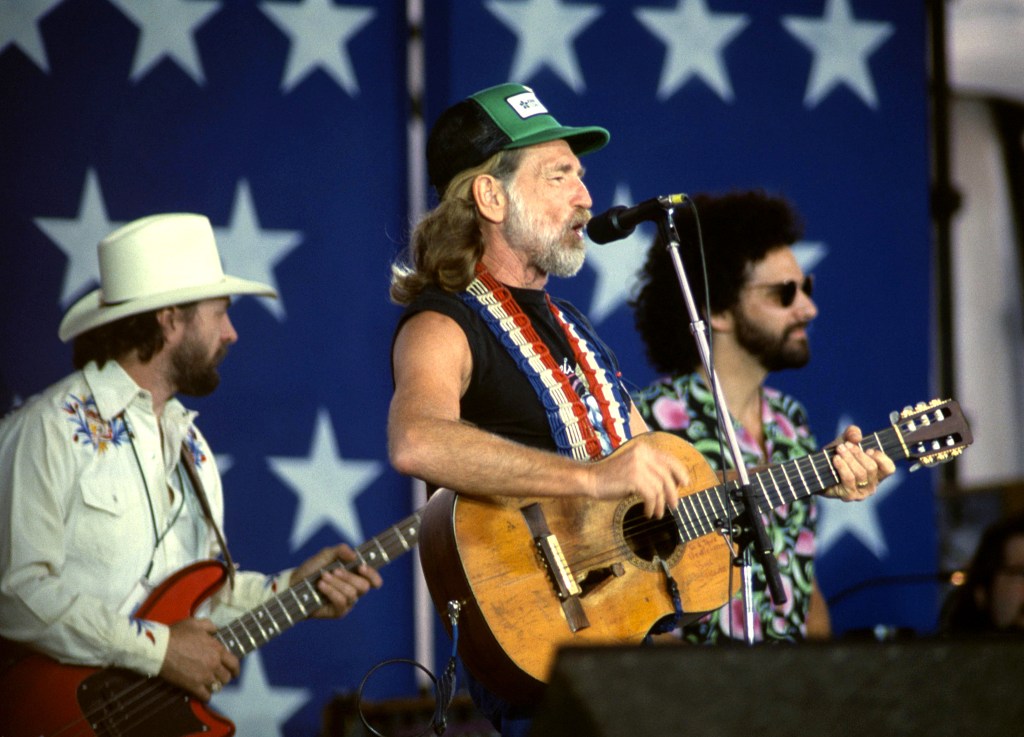Here’s a look back at what happened in the Chicago area on Sept. 22, according to the Tribune’s archives.
Is an important event missing from this date? Email us.
Weather records (from the National Weather Service, Chicago)
- High temperature: 94 degrees (2017)
- Low temperature: 32 degrees (1995)
- Precipitation: 1.73 inches (2006)
- Snowfall: Trace (1952)
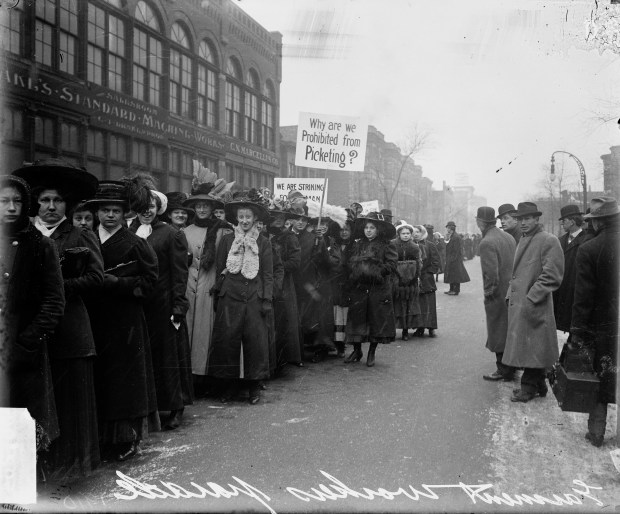 Women picket during the United Garment Workers of America strike in Chicago on Dec. 12, 1910. (Chicago History Museum)
Women picket during the United Garment Workers of America strike in Chicago on Dec. 12, 1910. (Chicago History Museum)
1910: Seventeen young women abandoned their sewing machines at the Hart, Schaffner & Marx clothing manufacturer in Pilsen, initiating a strike that lasted four months and eventually involved some 40,000 workers. They were furious because the Chicago clothing manufacturer had cut their rate from 4 cents to 3 ¾ cents a garment. Other female employees soon joined them — including their leader Bessie Abramowitz.
For their representative, the strikers chose Chicago attorney Clarence Darrow, the famed “defender of lost causes,” and on Jan. 16, 1911, workers began returning to Hart Schaffner & Marx’s shops on the hopes of a deal being reached.
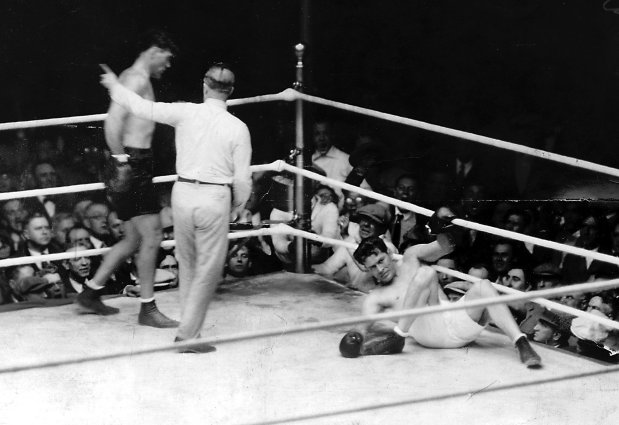 On Sept. 22, 1927, Jack Dempsey lost to Gene Tunney at Soldier Field but Tunney may have benefited when he was knocked down in what historians describe as the famous “long count.” (Chicago Herald and Examiner)
On Sept. 22, 1927, Jack Dempsey lost to Gene Tunney at Soldier Field but Tunney may have benefited when he was knocked down in what historians describe as the famous “long count.” (Chicago Herald and Examiner)
1927: “The Long Count” fight. The buildup to the Gene Tunney-Jack Dempsey heavyweight title bout was relentless; four days before the fight, the Tribune wrote: “Never in the annals of prize fighting has such a match as this been promoted.” Ticket sales exceeded $3 million — $1 million more than any prior championship.
Soldier Field was jammed with nearly 105,000 fans who came to see the rematch one year after Dempsey lost his title to the underdog Tunney.
In the seventh round, challenger and ex-champ Dempsey knocked Tunney off his feet for the first time in the champion’s career. But Dempsey was late moving to a neutral corner, so referee Dave Barry delayed starting his count. Most ringside reports agreed that Tunney had 13 seconds to clear his head before he arose on Barry’s “nine” count.
“I just couldn’t move,” Dempsey would say later about his delay in getting to the corner. “I wanted him to get up. I wanted to kill the SOB.”
Tunney got to his feet and went on to win the fight and retain the crown by unanimous decision.
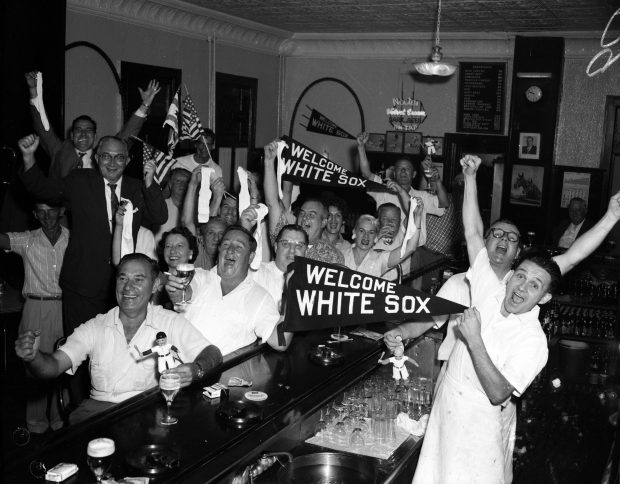 Patrons at “The Pump” yell and scream as the White Sox win their first pennant in 40 years on Sept. 22, 1959. The Pump was a tavern and restaurant at 3712 S. Halsted St. in Chicago. (Al Phillips/Chicago Tribune)
Patrons at “The Pump” yell and scream as the White Sox win their first pennant in 40 years on Sept. 22, 1959. The Pump was a tavern and restaurant at 3712 S. Halsted St. in Chicago. (Al Phillips/Chicago Tribune)
1959: Fittingly, the “Go-Go” White Sox clinched the American League pennant in Cleveland against a team they owned all season — beating them 15 times — with plenty of dramatics. The first White Sox pennant since 1919 (yes, that “Black Sox” team) came “with the bases filled with Cleveland Indians, only one out, and the White Sox in danger of losing a two-run lead,” the Tribune reported. Manager Al Lopez brought in Gerry Staley to stem the bleeding.
 The Chicago White Sox became American League champions on Sept. 22, 1959. Al Lopez became the first White Sox manager to win the pennant since Kid Gleason and the infamous 1919 team. (Chicago Tribune)
The Chicago White Sox became American League champions on Sept. 22, 1959. Al Lopez became the first White Sox manager to win the pennant since Kid Gleason and the infamous 1919 team. (Chicago Tribune)
The Tribune’s Edward Prell provided the historic play-by-play in the next morning’s edition: “Staley pitched one ball — a sinker low and outside. Vic Power swung and Luis Aparicio glided to his left, spearing the ball. For a split second, it seemed he thought of making the toss to Nellie Fox. But he flashed three or four steps, hit the base with his spikes, and rifled the ball to Ted Kluszewski at first base.”
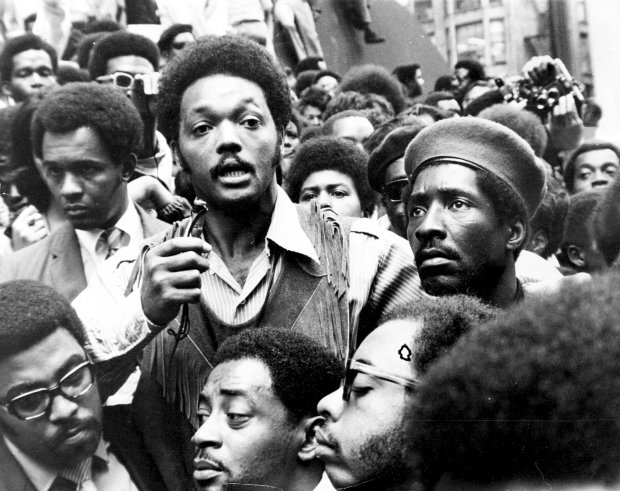 The Rev. Jesse Jackson addresses the crowd at a “Black Monday” demonstration near the Civic Center in Chicago on Sept. 22, 1969. More than 3,000 people attended the protest rally. The demonstration coincided with rallies being held in various cities across the nation protesting job discrimination. (Luigi Mendicino/Chicago Tribune)
The Rev. Jesse Jackson addresses the crowd at a “Black Monday” demonstration near the Civic Center in Chicago on Sept. 22, 1969. More than 3,000 people attended the protest rally. The demonstration coincided with rallies being held in various cities across the nation protesting job discrimination. (Luigi Mendicino/Chicago Tribune)
1969: Jesse Jackson lead a “Black Monday” protest before an estimated 3,000 people at Chicago’s Daley Plaza. The protesters then marched in objection to discriminatory union hiring practices.
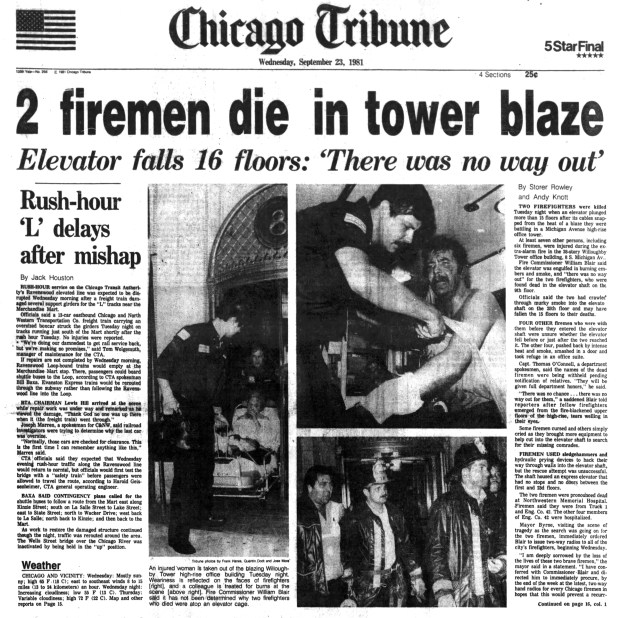 Firefighters used sledgehammers and hydraulic prying devices to hack their way through walls into the elevator shaft at Willoughby Tower, 8 S. Michigan Ave., on Sept. 22, 1981. Two of their crew members, Joseph Hitz and Craig McShane, were trapped by an elevator that plunged more than 15 floors during a fire in the building and were killed. (Chicago Tribune)
Firefighters used sledgehammers and hydraulic prying devices to hack their way through walls into the elevator shaft at Willoughby Tower, 8 S. Michigan Ave., on Sept. 22, 1981. Two of their crew members, Joseph Hitz and Craig McShane, were trapped by an elevator that plunged more than 15 floors during a fire in the building and were killed. (Chicago Tribune)
1981: Two Chicago firefighters were killed when an elevator plunged more than 15 floors after its cables snapped from the heat of a fire they were battling in the 38-story Willoughby Tower office building on 8 S. Michigan Ave.
Fire Commissioner William Blair said the elevator was engulfed in burning embers and smoke, and “there was no way out” for veteran Joseph Hitz and rookie Craig McShane, who were found dead in the elevator shaft on the ninth floor.
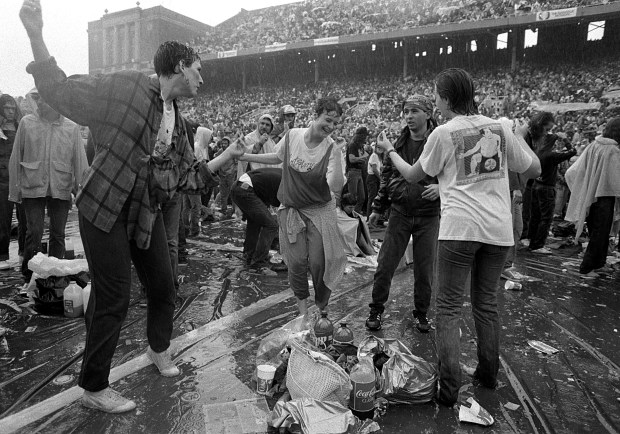 Concertgoers dance in the rain at the University of Illinois’ Memorial Stadium in Champaign during a wet Farm Aid on Sept. 22, 1985. (Ovie Carter/Chicago Tribune)
Concertgoers dance in the rain at the University of Illinois’ Memorial Stadium in Champaign during a wet Farm Aid on Sept. 22, 1985. (Ovie Carter/Chicago Tribune)
1985: The first Farm Aid concert took place in Champaign.
“It was the biggest country music concert in history,” the Tribune wrote. “For more than 14 hours, Memorial Stadium on the University of Illinois campus was transformed into Rockabilly Heaven before a rain-soaked but spirited crowd of about 78,000 and a national television audience estimated at more than 24 million.”
The event was the brainchild of country singer Willie Nelson, who was inspired by fellow musician Bob Dylan to hold a concert to raise money for American farmers.
Chicago weather: What’s normal for fall’s first freeze and first snow? And when does it happen?
1995: Chicago experienced its earliest first freeze of the fall season at O’Hare International Airport, the city’s official recording site.
Want more vintage Chicago?
Subscribe to the free Vintage Chicago Tribune newsletter, join our Chicagoland history Facebook group, stay current with Today in Chicago History and follow us on Instagram for more from Chicago’s past.
Have an idea for Vintage Chicago Tribune? Share it with Kori Rumore and Marianne Mather at krumore@chicagotribune.com and mmather@chicagotribune.com
